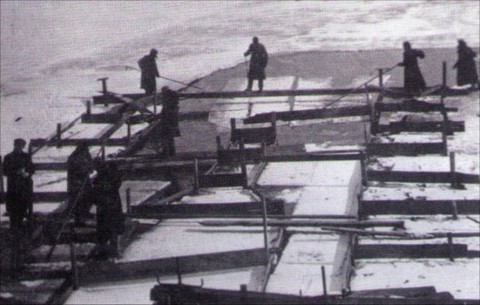
At the end of Wednesday’s post about one of the least heralded pioneers of refrigeration, we noted that the “ice lobby” had been instrumental in frustrating John Gorrie’s dreams of freezing water via mechanical means. This notion struck us as rather humorous since we can scarcely think of a less valuable commodity these days than ice, available at our local bodega for roughly 20 cents a pound. Yet as an astute commenter pointed out, naturally harvested ice was once so highly prized that New York City had its own fabulously wealthy “Ice King”: Charles W. Morse. A fair chunk of his story is told here:
The ice supply of New York came from the Hudson River and from the Kennebec and Penobscot Rivers in Maine, and the greater proportion of the supply was controlled by the Consolidated Ice Company and the Knickerbocker Ice Company. The former did almost all the wholesale and retail business in New York and the latter operated in Philadelphia, Baltimore. On March 11, 1899, Mr. Morse incorporated the American Ice Company under the laws of the state of New Jersey. The stock of the two old companies amounted to $20,000,000, although their property was not worth that amount. The American Ice Company exchanged its stock, share for share, for the stock of the two companies and then issued $15,000,000 more stock. The $35,000,000 was regularly listed upon the New York Stock Exchange…
[Morse] smoothed his way in another direction also. He was a good friend to Tammany Hall; Mayor Van Wyck and his brother and John F. Carroll were all shareholders in the ice company. Pleasant relations with the powers that be is a most valuable asset to an ice company, because it needs pier facilities. A very ice regard even for appearances would have prevented a mayor of the city from being interested in the Morse company, particularly since it was a monopoly. Yet Van Wyck and other Tammany politicians were in on it…
In the summer of 1900, the American Ice Company raised the price of ice in New York from thirty cents to sixty cents a hundred pounds, which caused untold suffering among the poor. The company became known as the Ice Trust and “Ice Van Wyck” was used as a term of reproach.
Morse erred by increasing the price of ice too much, and thus causing widespread public fury that provided a political opportunity for self-styled reformers. An ensuing investigation found that the Ice Trust enforced its monopoly through violence, and the criminal case against Morse helped bring down Tammany Hall as well. And therein lies a classic lesson for blackhearted schemers: it is often better to steal little than steal big.
Also of interest: artificial ice was technologically feasible during the Ice Trust’s heyday, and the finished product was purported to be much cheaper, too. But plans to build ice factories often came to naught because of an urban legend regarding manufactured ice: that it released noxious gases as it melted. We wouldn’t be surprised in the least if Morse was the man behind that bit of scientifically fallacious gossip.


danthelawyer // Jul 9, 2010 at 1:24 pm
This seems to be an instance of “Pigs get fat; hogs get slaughtered.”
Brendan I. Koerner // Jul 9, 2010 at 1:30 pm
@danthelawyer: Ah, a much better (and folksier) applicable axiom. Yes, exactly–doubling the price overnight was Morse’s downfall. He could have avoided the blowback with a more modest increase. And he still would’ve been a zillionaire.
Captured Shadow // Jul 9, 2010 at 2:04 pm
Near my hometown there was/is an ice cave.
http://en.wikipedia.org/wiki/Arnold_Lava_Tube_System
I am not sure I really understand the thermodynamics and heat transfer of how this works. Cold winter air sinks into the cave, water dripping in, then freezes, and the ice builds up. In summer it melts a bit, but the hot air never sinks down to the cave level keeping some ice frozen all year long. It seems like the rocks would have more thermal mass than the air and eventually melt the ice but maybe rock conductivity is low enough to allow the pocket of cold to remain.
It was used as an ice mine back in the day.
Brendan I. Koerner // Jul 9, 2010 at 2:30 pm
@Captured Shadow: I’m adding “ice miner” to my list of jobs I’d never, ever want. Pretty amazing that it used to be economically feasible back in the day.
Jordan // Jul 9, 2010 at 4:22 pm
@Captured Shadow
Two points: first, cold air is denser, so it tends to sink. Thus the cold air will tend to be trapped in the caves and there won’t be as much heat exchange with the outside because the air won’t circulate. Secondly, rock is going to be a really good insulator, so once you’ve trapped a bunch of cool air down there and brought the temperature of the surrounding rock down, it’s going to take a lot of heat to change that.
scottstev // Jul 12, 2010 at 8:55 am
@Brendan and @Captured Shadow: I would avoid any job that sounds like a plausible prison sentence in science fiction movie.
Brendan I. Koerner // Jul 12, 2010 at 9:16 am
The first thing I thought of upon reading the ice-caves comment was the giant ants’ underground sugar caves:
http://www.hulu.com/watch/17611/the-simpsons-giant-space-ants